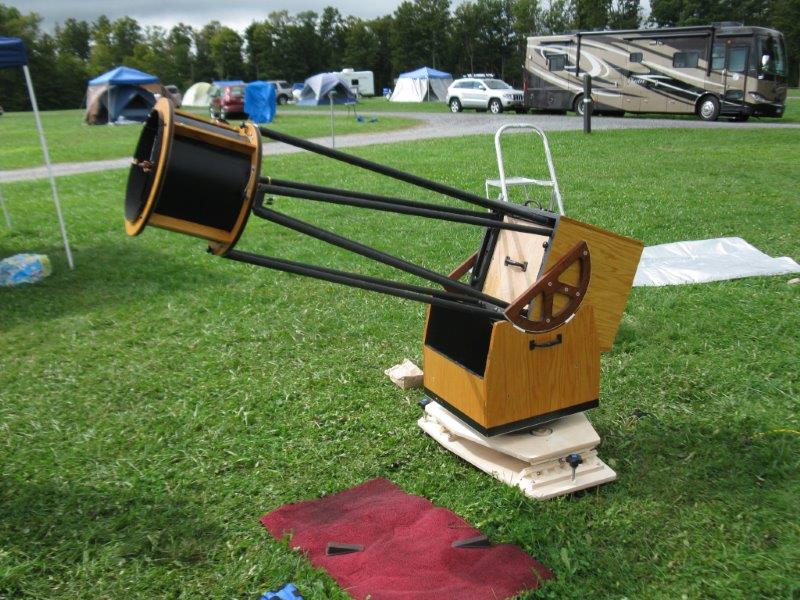Measuring your telescope

Update September 15th: Very soon there will be a SkyStopper Youtube channel, with a good video showing how to measure your telescope. You will need a broom handle, a level, a measuring tape and a scale big enough to weigh yourself while you are holding a part of your telescope.
Click here for the video about measuring
Click here for a video showing setup considerations This video is scheduled to be re-done with better audio. It was a windy day :(
The SkyStopper is custom made for your telescope. That allows it to operate almost perfectly balanced, which has numerous advantages. Because it is balanced, it does not shift its weight as your telescope is moved. The weight on each foot remains constant, allowing it to be set up on grass without concern for sag due to the ground settling as it tracks.
To make the SkyStopper balanced, we need to determine the height and position of the center of gravity of your telescope, and the overall weight of your telescope. When this is combined with the weight of the platform, a composite center of gravity is computed, and the SkyStopper is built so this center of gravity is on the axis of rotation.
That said, the SkyStopper is strong enough to track unbalanced too, even badly unbalanced telescopes have been carried, so don't fret too much about high accuracy here. We just need to be within a few cm for ideal performance.
My email is smrg@cogeco.ca
The best way to measure a skystopper is to send me an email with a photograph of the intended telescope, along with the measurements. If i need clarifying information, i will be able to refer to landmarks on your telescope thanks to the photo.
Here's the measurements we need.
This is most important for triple axis SkyStoppers. The feet of the telescope form a triangle. The guide actuator will grip one of the legs. Either I can supply you with standard feet 3/4 inch in diameter, which you can attach to your telescope, or we can ensure that the SkyStopper has the right size grabbers to hold your telescope, via measurements. In most cases, the new feet are used. I supply stainless steel screws for attachment.

The SkyStopper will work best near balance. It will be easier to point your telescope and easier to attach the linkage.
We need to measure the weight of the OTA, the weight of the base, and the height of the OTA pivot, and the height of the COG of the base alone.
The weight of the SkyStopper moving platform will be included in the computation to achieve perfect balance if possible. Normally a safety margin is included to place the actual center of gravity of the scope+platform below the main axis of rotation, so the scope tends to the center position.
Of course, your preferred observing latitude or latitude range needs to be specified, and the preferred tracking duration and overall height added to the telescope. You should allow for about 7 inches added to the height at the eyepiece unless we take special measures to keep it lower. There are trade-offs there, and severely constraining one of added height or duration puts limits on the other parameter.
The safety margin against tipping of the telescope needs to be computed. Any scope will tip if you push it hard enough, but at the ends of travel, the platform is already tilted about 9 degrees, so there needs to be sufficient stability in the telescope geometry to prevent it from getting tippy.
There are a couple of ways to achieve this. Having a telescope with a large ground board and well spaced feet is the major way. I have made ground board extenders for some customers when their center pivot was too small. It's not practical to bolt the telescope to a triple axis platform for extra stability, but in extreme cases, short flexible connections (chains) could be used to help guard against tipping. I find that a 2 inch tipping safety margin is sufficient, provided the scope is naturally balanced on the platform and does not pick up speed or tip when the linkage is disconnected. Ultimately, the duration before reset determines the maximum angle of the platform, and can be scaled back for telescopes with a high center of gravity.